Beauty is never enough for Mira Lehr. She likes setting fires.
Incendiary dangers burn their way into Lehr's luminous paintings and sculpture. Her recent art incorporates gunpowder stains and residue of ignited fuses.
There’s also welded steel, marine ropes, cast resins, and countless brushstrokes of purely sensual painting. Floating throughout are echoes of abundant foliage blooming beyond her studio: citrus trees, bromeliads, night-blooming jasmine, and more. They mesh to create art burnished bright with chimerical, edgy allure.
.

"Vegetata Mirabellis" by Mira Lehr, 2010. Mixed media and gunpowder on Japanese paper, 96 x 96 inches. Collection Pérez Art Museum Miami, gift of Lin Arison. Photo credit: Sid Hoeltzell.
.
"Mira Lehr: Arc of Nature," with chiefly abstract work summoning beauty suffusing the natural world, runs May 7 to June 27, 2015 at New York’s Flomenhaft Gallery, on West 27th Street.
A petite, elegant woman who loves to experiment, she's unfazed by combustible consequences of working with gunpowder in the yard outside her studio. "I'm never afraid--it is stupid sometimes if the wind blows the wrong way," she admits. "Of course, my neighbors think I'm crazy."
.
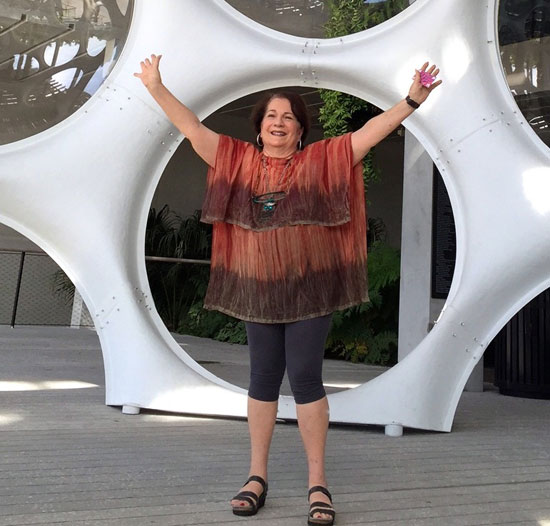
Mira Lehr in Buckminster Fuller's "Fly Eye Dome" when temporarily installed on the plaza of Perez Art Museum Miami. Photo by Jonathan Traviesa.
.
"Painting Is Power"
More about that B-word. No less an authority than legendary art historian Irving Sandler, whom she has known for at least two decades, has called her work beautiful, also acknowledging that sometimes she seems to work against the idea of beauty. To this observation, Lehr replied, "I don't like people saying 'it's pretty, it's so beautiful.' I want the work to have impact, to be powerful. To me, the essence of painting is power." This exchange happened during a 2007 interview Sandler conducted at her Miami Beach studio for the Getty Research Institute and Smithsonian Institution Archives.
.

"Babablue1" by Mira Lehr, 2014. Mixed media, 72 x 54 inches.
.
Lehr added at the time, "So if one is labeled as 'beautiful,' or 'pretty,' that can take away from what I've been working so hard to try to find--an underlying structure … I like a tough beauty , one that comes from internal movement and relationship, not the superficial." The interplay of a composition's formal elements, especially space and color, remains essential for Lehr.
.
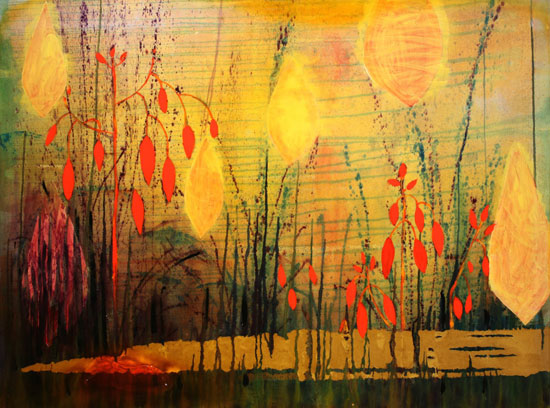
"Sand Bar" by Mira Lehr, 2014. Mixed media, 54 x 72 inches.
.
In 1984, she began taking part in exhibitions, including "A Century of Women's Achievements" at Louisiana's World's Fair in New Orleans, Louisiana, and "Women's Caucus for Art Travels" at the Philadelphia Art Alliance. More recently her art has been exhibited at galleries in New York, Boca Raton, and Miami, as well as the Bass Museum of Art, Miami Art Museum (renamed Pérez Art Museum Miami), and the American Embassy of Mexico City, Mexico, and Sofia, Bulgaria. Her work hangs in the lobby of the Evelyn Lauder Breast Center of the Memorial Sloan Kettering Cancer Center and is included in the Leonard Lauder Corporate Collection.
Available at Flomenhaft Gallery are copies of the book Arc of Nature by Mira Lehr, recently published by Hudson Hills Press. It includes essays by Eleanor Heartney, interviews with Irving Sandler, and a foreword by Thom Collins.
Still, it's been a long and circuitous path to the current Flomenhaft exhibit.
Having received a superb education in art history at Vassar College in the 1950s, Lehr was for years a passionately committed abstract painter, juggling the often conflicting roles of wife, mother, and artist. After graduating from college and until she began exhibiting about three decades later, she painted steadily when she could and sought out guidance from distinguished artists and teachers. These included Robert Motherwell and Hans Hoffman disciple James Billmyer.
.
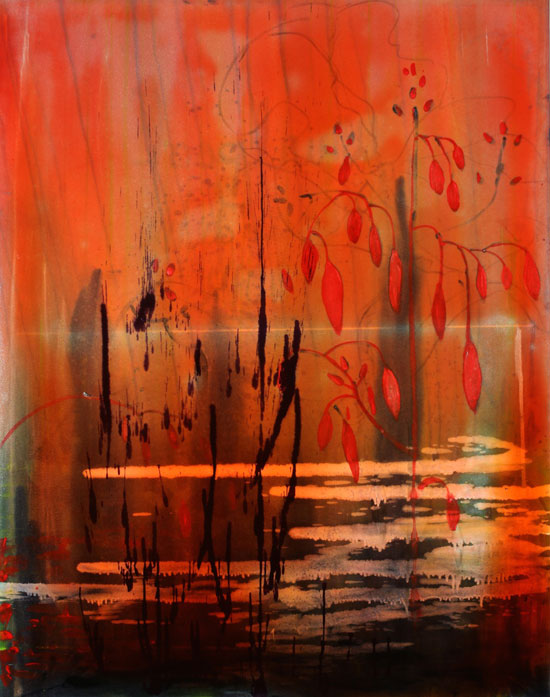
"Whirlpool" by Mira Lehr, 2014. Mixed media on canvas, 60 x 47.5 inches.
.
This was an era of little or no art world support for a Miami Beach woman forging what today we would call an artistic career: selling work through a distinguished gallery and gaining the attention of scholars, critics, museum directors and curators.
When Lehr moved with her husband from New York to Miami Beach in 1960, it was "like a desert island," she said with a laugh during an interview in her studio on April 20, 2015. She befriended other women artists.
"We all hated being here," she recalled. "This was the boonies, nobody paid attention. Being a woman artist at that time was difficult. I thought, 'I'm just doing this because I love when I'm learning. Whatever happens, happens.'"
.
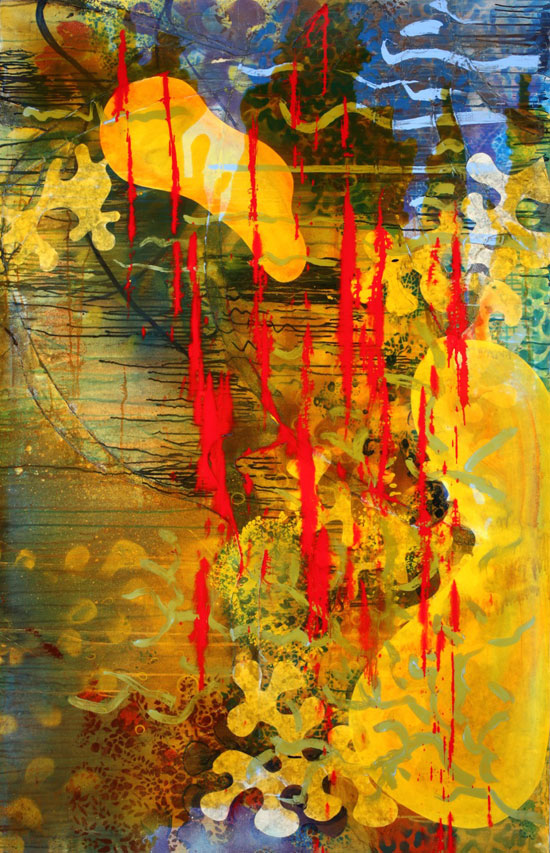
"Kelp Garden" by Mira Lehr, 2014. Mixed media, 77 x 50 inches.
.
Out of desperation, Lehr co-founded Continuum Gallery, one of the first women's co-op galleries in the Southeast. From 1960 to the early 1990s, it played a distinctive role in a city better known for sun 'n' fun than culture, by organizing workshops for members, presenting public programs, and inviting out-of-town professionals to expand the community's understanding of contemporary art.
An intellectually curious woman, Lehr crossed paths with Buckminster Fuller during the summer of 1969, when she was part of a group of artists, writers, and scientists working with Fuller on an ambitious project he called "World Game," envisioning humanitarian alternatives to global warfare by conserving natural resources.
But not until 2001, when she had a sold-out gallery exhibit, did Lehr really consider herself a professional artist. "This is not bad. I like dealing with the outside world," she remembers thinking. "I was so surprised and touched that people loved my work and paid money for it. You can just keep putting the art in your friends' houses or in your closet for only so long."
Subtropical Florida: Fertile Source of Inspiration
Since that time she has really moved ahead in her exploration of materials and subject matter. She's found the natural, marine world of subtropical Florida a fertile source of inspiration.
Three-dimensional works further engage her free-flowing imagination. "Because I had no background in sculpture," she said, "I had no voices looking over my shoulder telling me what's good, what's bad."
The entwining miniature forests of mangrove roots lining so much South Florida coastline have clearly made a mark on her art. Such "forests" are emblems of a landscape in constant flux, moving forward into Biscayne Bay and then swept back by storms and development.
The fluid, spatial complexity of sculpture such as "Indefinite Integral" suggests an affinity with the interlocking forms of mangrove roots. Call it a marine-inflected mobile, surging to the height of 12-foot-tall waves. Translucent colors in yellows, blues, and greens suggest intermittent sunlight splashing on waves re-inventing the coastline--surely a quietly ominous reference to an area threatened by flooding from rising seas.
.
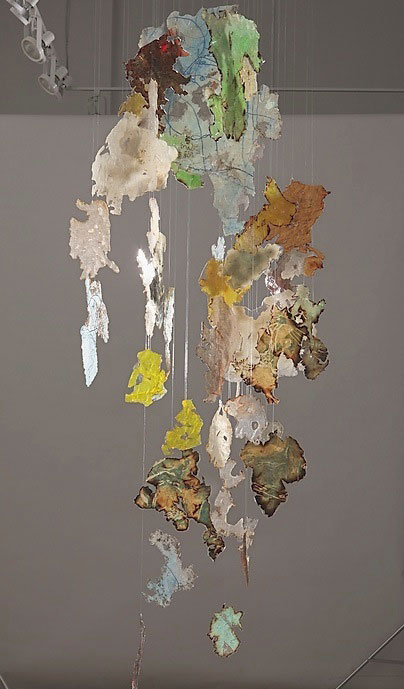
"Indefinite Integral" by Mira Lehr, 2011. Woodblock on burned Japanese paper, stainless steel, resin, 32 x 98 x 32 inches.
.
Around 2012, Lehr began adding to her three-dimensional vocabulary by pouring resins over Japanese paper, creating abstract forms or shapes recalling jellyfish. In Acqualina, included in the Flomenhaft exhibit, wave-like shapes combine with undulating skeins of gunpowder residue to create a dynamic composition.
.

"aqualina" by Mira Lehr, 2015. Resin, ink, ignited fuse on panel, 48 x 60 inches.
.
These glistening shards of resin are often hung from ceilings, creating what she considers "mysterious forests." By adding welded steel wire, copper mesh, jute and other industrial materials, she constructs large-scale three-dimensional works, including the extraordinary Diel Migration (2013).
.
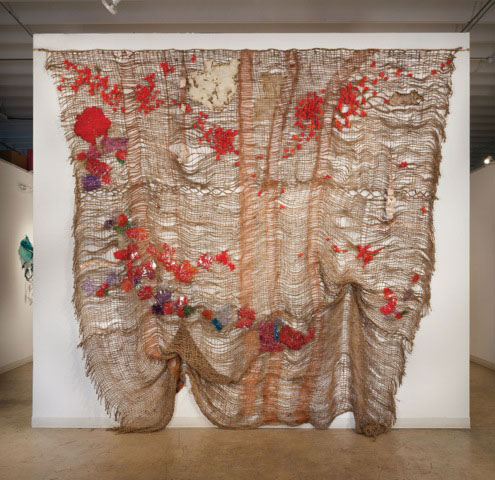
"Diel Migration" by Mira Lehr, 2013. Jute, keystone, copper mesh, Japanese paper, ink, resin, copper emulsion, 12 x 12 feet.
.
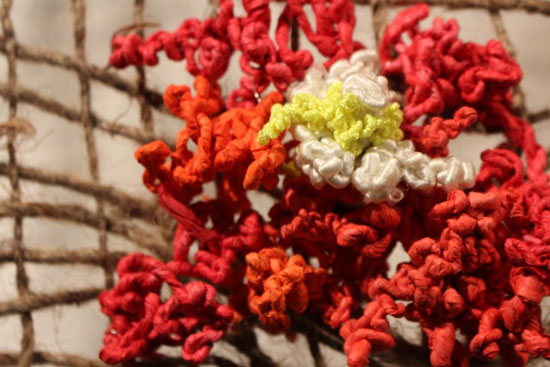
Detail of "Diel Migration" by Mira Lehr, 2013. Jute, keystone, copper mesh, Japanese paper, ink, resin, copper emulsion, 12 x 12 feet.
.
As Lehr explains in the book Arc of Nature, "Diel migration is one of the largest migrations on our planet, taking place like clockwork across the world's oceans. It is a vertical migration that many pelagic organisms, primarily tiny plankton, undertake each day."
She's just beginning to navigate the vast arc of nature transforming subtropical Florida. On the drawing board are proposed public art projects for two iconic Miami landmarks, Fairchild Tropical Botanic Garden and Vizcaya Museum and Gardens.
She'd like to sculpt a giant spider web for Fairchild. "My art is not so much about the appearance of nature,” she said, “as much as how nature works."
_______________________
BASIC INFO: "Mira Lehr: Arc of Nature," May 7 to June 27, 2015, at Flomenhaft Gallery, Suite 200, 547 W. 27th Street, New York, NY 10001 www.flomenhaftgallery.com.
_______________________
Copyright 2015 Hamptons Art Hub LLC. All rights reserved.
